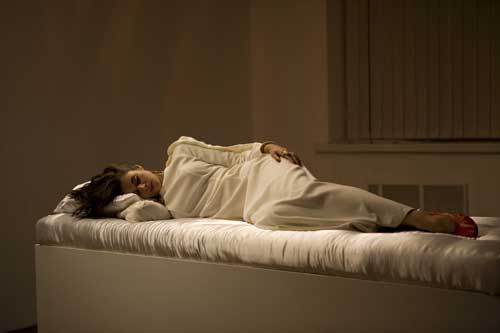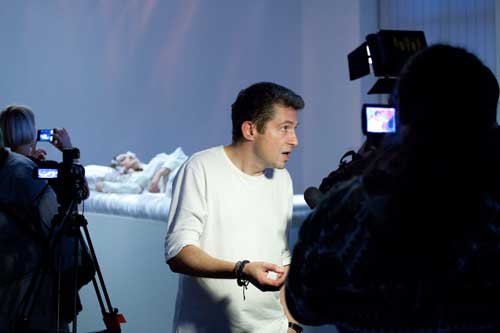Once upon a time in a land far away, a beautiful maiden lay asleep on a bed of white satin, waiting to be awoken by true love's first kiss. People came from all over and gazed in wonder as the beauty stirred, turned and dreamed – her face relaxed yet somehow filled with hope – waiting day after day for Prince Charming to appear and free her from cursed inertia. Many suitors tried to awaken her. Many failed. Would the moment ever come? Would Sleeping Beauty awake to a life of full awareness and joy? Or would she be doomed to stay asleep forever, frozen in time for the lack of something that perhaps doesn't exist?
We've all heard the fairy tale, and we all know how it ends – in children's books at least. But when the story is real and happening before our very eyes, who's to say how things will actually unfold? Especially when Prince Charming has to sign a legally binding contract stipulating that he will marry the sleeping woman should she open her eyes to his kiss.

Such was the scenario that University of Lethbridge art professor Taras Polataiko brought to life in his appropriately entitled exhibit, Sleeping Beauty, held at the National Art Museum in Kiev, Ukraine (Aug. 22 to Sept. 9, 2012). A gorgeous girl lying in wait, dozens of hopeful suitors ready for their chance, and both parties willing to commit their lives to each other based on the feeling of a single kiss. It's a provocative scenario, but even Polataiko didn't expect the media frenzy that ensued – a daily maelstrom of international attention from news groups around the globe, including the likes of the Associated Press, Reuters and the BBC.
"It was really very strange. I can't quite wrap my mind around it," says Polataiko of all the interest. "It was supposed to be very gentle – a tender, magical, quiet show. Instead, I had television crews in the gallery every day."
The response to Polataiko's exhibit might be surprising, but the way Sleeping Beauty captured the imagination of millions around the world and in all languages is easy to understand. Consider it: a fairy tale made real. The opportunity to kiss a beautiful girl who is willing to spend her life with you if your touch ignites her soul. The idea that true love might actually exist and is waiting for you to come claim it. It's hypnotic and gender-charged and manages to raise questions while remaining enchanting.
Taking place in Ukraine's capital city of Kiev, it also functions as an allegory of political unrest in Ukrainian society that, like all allegories, often reveals psychological truths deeply imbedded in the human psyche.
"Initially the thinking was to create something meaningful for Ukraine," says Polataiko. "The social and political history of the country is very traumatic. I wanted to create a show that reflected the sense of apathy Ukrainian people feel because of all they've endured. The concept for the show was based on the idea of being endlessly patient and waiting for something powerful to happen."

Born and raised in Ukraine, Polataiko knows the social and political climate of the country very well. He was pursuing a career in North America when the Orange Revolution took place in Ukraine in 2004, but he flew back specifically to take part in the uprising. Knowing that the exhibit could tread on touchy ground, Polataiko kept the political aspect of his concept quiet over several months of preparation, all the while interviewing dozens of potential candidates to fill the role of Sleeping Beauty.
"That was when the work started to get really interesting – when I was talking to the girls and listening to their motivations for getting involved," says Polataiko. "The stakes were very high. We were talking marriage – the possibility of committing yourself to a stranger. Most of the girls I spoke to were hoping to find true love."
Polataiko eventually selected five "beauties" to sleep in shifts over the course of his three-week exhibit. Their only requirement: to respond to a kiss that compelled them to open their eyes. Princes, on the other hand, had to meet more rigorous conditions. They could be either male or female but had to be more than 18 years of age, single and serious enough about marrying the beauty to sign a contract to that effect if they awakened her. Only one kiss per prince was permitted, and it had to be given respectfully.
Polataiko, and hundreds of thousands of viewers who watched the fairy tale unfold via live streaming video, were blown away by the sincerity of the suitors who took a shot with fate. One potential groom broke down in tears when his kiss failed to break the spell.
"The space was very intense, super charged, but at the same time extremely tender, kind and hopeful," says Polataiko. "The beauties and princes were vulnerable and brave all at once. There was a lot on the line for both of them."
Polataiko began teaching at the University of Lethbridge in 2010. He'd been previously working in New York as a full-time artist for several years, but opportunities to create dried up with the market crash. It was a stroke of good luck, all the same.
"I like it here," says Polataiko from his campus office. "The artistic community is friendly and very supportive. My work is happening here. I'm able to use Lethbridge as a successful base, and I would like to stay and continue teaching at the University of Lethbridge, if a permanent position were to present itself."
Sleeping Beauty received so much international coverage that viewers of the exhibition labelled Lady Gaga as a copycat artist after she staged a strikingly similar production in New York City. Gaga slept in a large stage set shaped like a bottle at the launch party for her new perfume several weeks after Polataiko's show was all over the news. Although Polataiko isn't impressed with the singer's commercial take on his concept, he's gracious enough to respond by saying, "Imitation is the highest form of flattery."
After days of kisses without an awakening, it looked as though Polataiko's Sleeping Beauty might never open her eyes. But one suitor did eventually draw her from slumber. Ironically, the kiss that did the trick wasn't a passionate lip lock with a virile Adonis. It was a gentle peck on the forehead – administered by a woman. Polataiko isn't sure if the women will abide by the contract and marry. It's a complicated scenario given that same-sex marriage is illegal in Ukraine. A fairy-tale ending is therefore probably not in the cards for the newfound couple, but Polataiko believes the importance of his exhibit is bigger than this result.
"Sleeping Beauty is the very essence of human existence. It's about that magical feeling that binds two people together, produces children and continues life," says Polataiko. "It's about the most fundamental thing we have – love. What's bigger than that?"
Sleeping Beauty closed on Sept. 9, 2012. Polataiko hopes to reopen the show in other global cities in the future.
This story first appeared in the Fall 2012 issue of SAM. For a look at the full issue in a flipbook format, follow this link.
